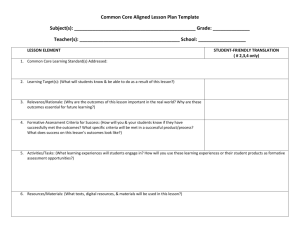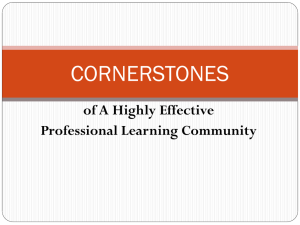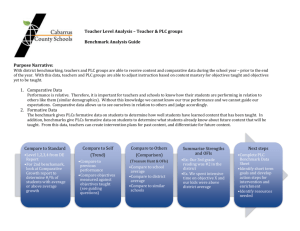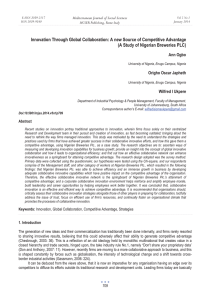Systemic Transformative Actions for Improved Productivity
advertisement
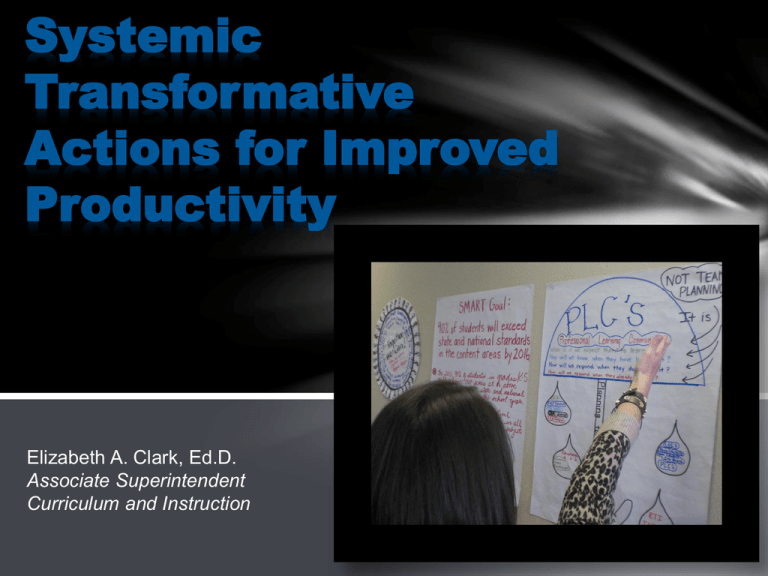
Systemic Transformative Actions for Improved Productivity Elizabeth A. Clark, Ed.D. Associate Superintendent Curriculum and Instruction Schedule for LOL 8:00 - 9:00 Systemic Transformative Actions for Improved Productivity 9:00 - 9:45 Using a Scenario to Address PLC Questions 2 and 3 9:45 – 10:00 Break 10:00 - 10:30 Book Study 10:30 – 11:00 Preview of Professional Learning Evaluation Moving from Current Status to Preferred Future Current Status Strategic Action Vision of Preferred Future Random Acts of Improvement Aim of the District District Goals & Measures …will not lead to sustained improvement over time. Random Acts Leave Children Behind school starting line teaching testing Aligned Acts of Improvement Aim of the District Quality improvement is eliminating random variation around an optimal targeted value. District Goals & Measures PLC in Birdville ISD Last LOL meeting, we focused on and discussed strategies around Question 1 of the PLC: What do students need to know and be able to do? PLC in Birdville ISD This time, we want to focus on and discuss strategies around Question 2 and Question 3 of the PLC: 2. How do we know if students know and can do what we have taught? 3. How do we respond when students aren’t successful in learning what we have taught? The Work of Leaders… Building shared responsibility for student learning is an ongoing journey that requires leadership at all levels, organizational and personal alignment, planning and effective teaching. CURRICULUM. DATA. COLLABORATION. System Curriculum Alignment Model Written Curriculum School System Classroom School Articulation Taught Curriculum Coordination Tested Curriculum Dynamic Organizations Continuous Improvement Process Model Continuous Improvement Is the result of a pragmatic, systemic and systematic process driven by customer needs, expectations, and requirements. Adhering to a Continuous Improvement Model Validates the need for improvement Clarifies organizational purpose, goals and measures Creates a system-wide and systematic approach to continual improvement Translates the approach into aligned actions at all levels of the organization Provides a results orientation based on data Moves the organization to improve Teachers Are the prime deliverers of the mission of the school system Are the most important group in the organization in terms of the organization accomplishing its goals Need professional development to be goal-focused, needs-driven, collaborative, and providers of quality instruction using high leverage strategies based on best practice CURRICULUM.DATA.COLLABORATION The Transformational Cycle Rules Roles Relationships Norms The Transformational Cycle Transformational Phase Uncertainty Phase Panic Exhaustion Experimentation Synergy Illusion Routinization Phase Stagnation CONNECT. LEAD. INFLUENCE. Initiation Phase Robert Quinn CI Components System Alignment – Removal of Slack Systems Improvement - Focus on Results Systems Integration - Coherency “The main thing is to keep the main thing THE MAIN THING.” Stephen Covey NO SURPRISES FOR CHILDREN “Most of us seek quantum leaps in our performance levels by following a strategy of incremental investment. This strategy simply does not work. The land of excellence is safely guarded from unworthy intruders. At the gates stand two fearsome sentries—risk and learning. The keys to entrance are faith and courage.” Robert Quinn How do we know if students know and can do what we have taught? Goals for today: Build shared knowledge around Question #3: How do we respond when a student experiences initial difficulty in learning? Understand RtI roles and responsibilities and begin thinking about implications for your campus. Instructional decisions regarding students not making adequate progress should be determined during a Collaborative Conference, based on a preponderance of evidence of student performance and the most appropriate setting for delivering the required intervention. A Collaborative Conference is a group of education professionals coming together to consider student-specific data, brainstorm possible strategies/interventions, and develop a plan of action to address a student-specific need. A collaborative team focused on student learning whose members work interdependently to achieve common goals for which they are mutually accountable. Review the roles and responsibilities document, considering implications for your campus Record each implication on a sticky note and post on wall chart. Professional Learning Community Collaborative Conference Divide and Conquer Record your ideas here. At your table, examine and discuss Chapter ___. Record important points from your reading to share with other groups. What implications does this chapter have for your campus? Share examples of formative assessments from your campus. 4



